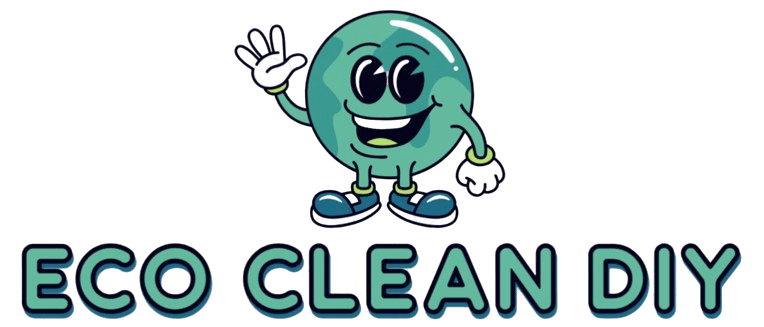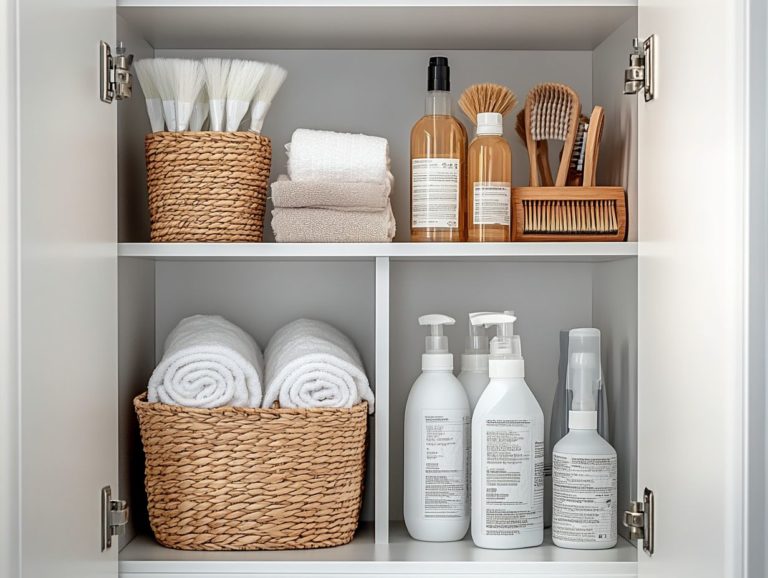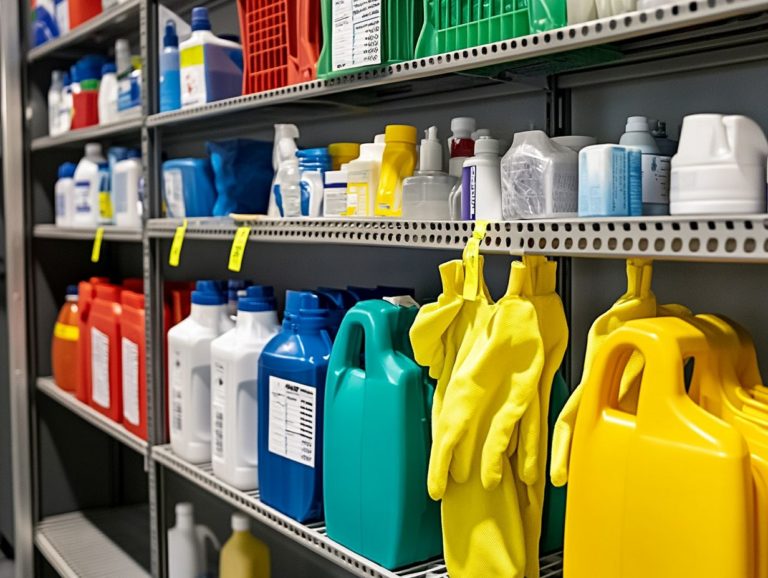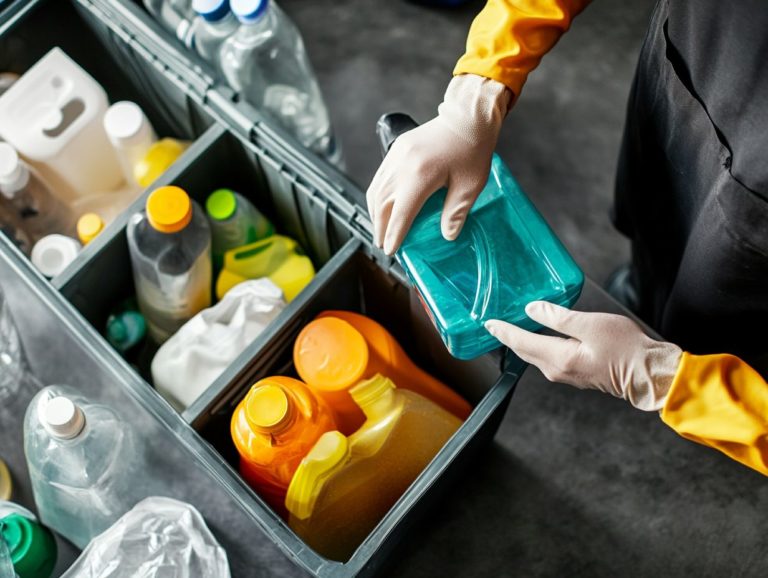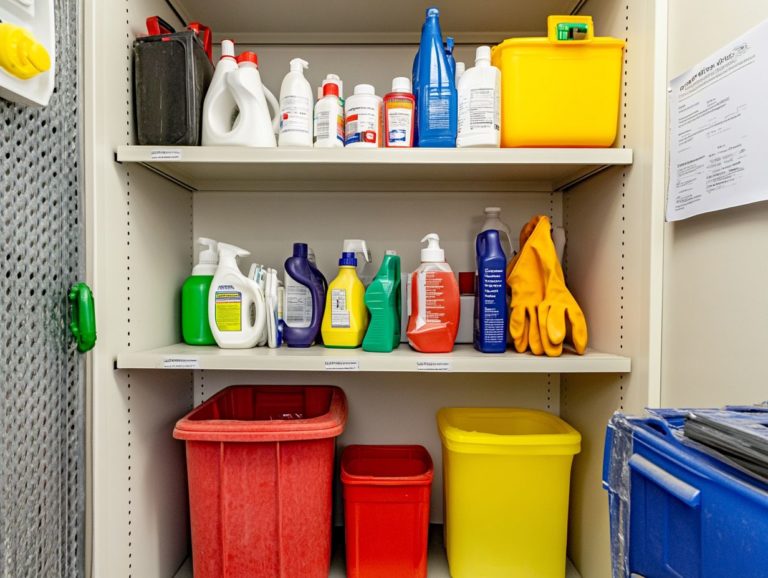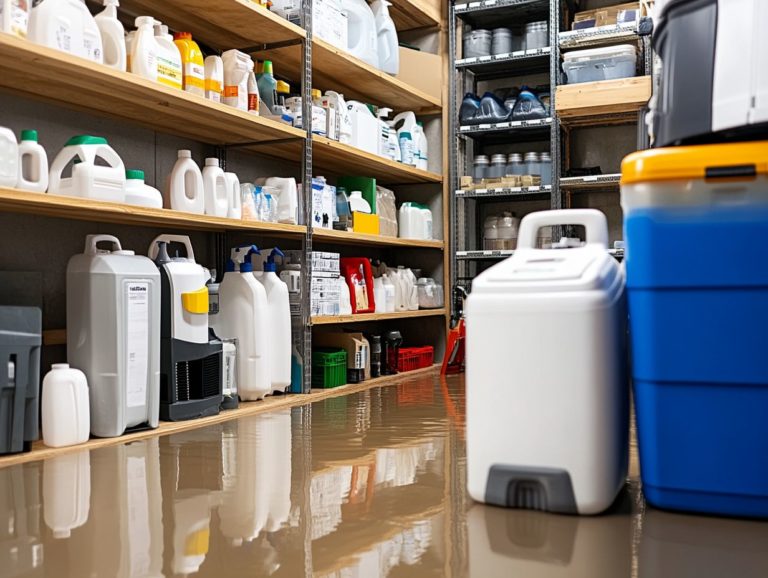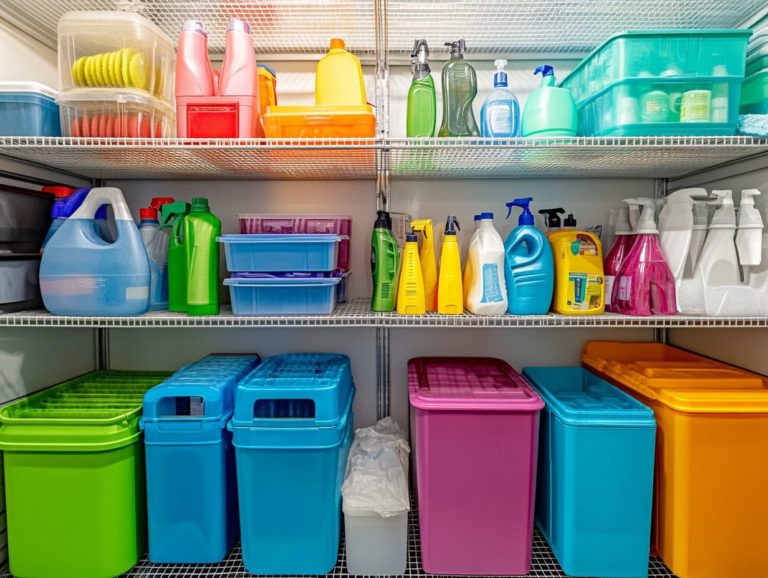How to Store Cleaning Supplies with Care
Storing your cleaning supplies properly is crucial for safety, efficiency, and longevity. Don’t wait effective storage prevents accidents and keeps your home safe.
From chemical cleaners to natural alternatives and essential tools, each type comes with specific storage requirements that can greatly influence their effectiveness and safety. This discussion delves into the significance of proper storage, providing you with practical tips for organizing your various cleaning products and storage containers while also highlighting common pitfalls to avoid.
By following these guidelines, you can ensure that your cleaning supplies are utilized effectively and safely, keeping your home clean and free from hazards. Regularly reviewing cleaning safety guidelines and product labels ensures compliance and enhances safety.
Contents
- Key Takeaways:
- Why Is It Important to Store Cleaning Supplies Properly?
- What Are the Different Types of Cleaning Supplies?
- How Should Chemical Cleaners Be Stored? Cleaning Safety Guidelines
- How Should Natural Cleaners Be Stored?
- How Should Tools and Equipment Be Stored?
- What Are Some General Tips for Storing Cleaning Supplies?
- What Are Some Common Mistakes When Storing Cleaning Supplies?
- Frequently Asked Questions
- How do I properly store cleaning supplies with care?
- What is the best way to organize my cleaning supplies?
- Can I store different types of cleaning supplies together?
- How should I store liquid cleaning products?
- What is the best way to store cleaning cloths and sponges?
- Is it okay to store cleaning supplies in the garage?
Key Takeaways:
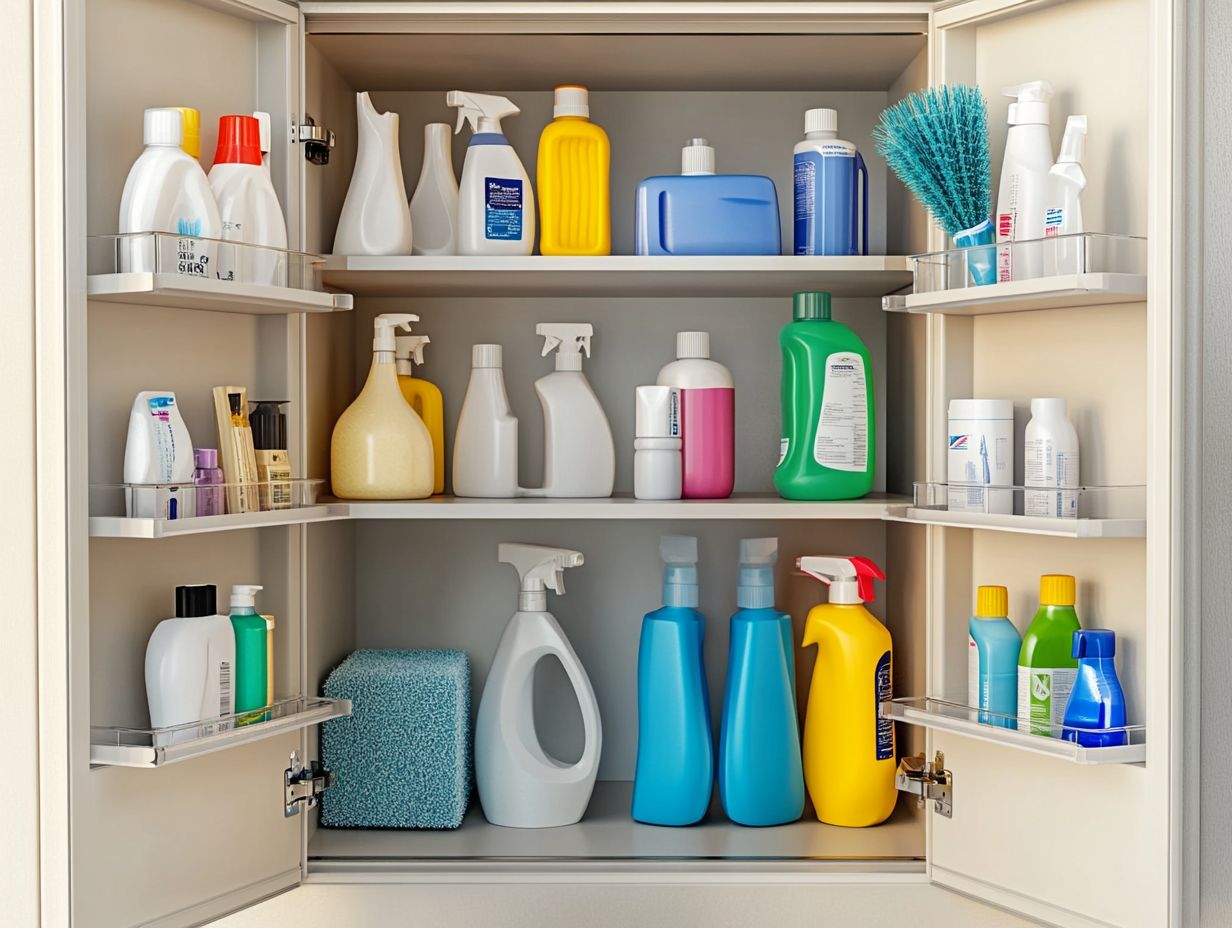
- Properly stored cleaning supplies last longer and are safer to use.
- Chemical cleaners should be kept in their original containers, in a cool, dry place, and out of reach of children and pets. Follow safety tips for chemical cleaners to avoid accidental exposures.
- Natural cleaners should be stored in airtight containers, in a cool, dark place, and labeled clearly.
Why Is It Important to Store Cleaning Supplies Properly?
Proper storage of cleaning supplies is essential for ensuring your household’s safety, especially when it comes to harmful chemicals and cleaning products. These can lead to accidental exposures. A well-organized cleaning storage area boosts your cleaning efficiency and significantly reduces the risk of accidents, particularly in homes with children.
By following guidelines from trusted organizations like the American Cleaning Institute and consulting resources like the Poison Help Line or the National Capital Poison Center, you can establish cleaning routines that prioritize safety and comply with product instructions. Using safety tips can help you minimize risks associated with cleaning solutions, underscoring the importance of careful organization in your approach to household cleaning.
What Are the Different Types of Cleaning Supplies?
Cleaning supplies come in various categories, each serving a distinct purpose in creating and maintaining a clean and healthy home environment. You ll encounter chemical cleaners, which are products specifically made to remove tough stains and disinfect surfaces, alongside natural cleaners that utilize biodegradable and non-toxic ingredients, catering to your eco-conscious preferences. Effective cleaning product storage and adherence to cleaning safety guidelines enhance your household cleaning efforts.
Moreover, essential cleaning tools and equipment think mops, brooms, and vacuum cleaners constitute the backbone of any effective household cleaning routine. Following cleaning practices and safety precautions recommended by experts ensures a safe and efficient cleaning process.
1. Chemical Cleaners
Chemical cleaners serve as powerful allies in your household cleaning arsenal, expertly designed to eliminate dirt, grime, and germs from various surfaces. While they are powerful, you need to handle them with care due to the potential health risks associated with household chemicals. Many of these products contain strong ingredients that can pose hazards if misused or improperly stored.
Within the realm of chemical cleaners, you ll encounter a range of options, including disinfectants, degreasers, and multipurpose cleaners, each tailored for specific cleaning challenges. For example, disinfectants like bleach are remarkably effective at killing bacteria and viruses, including those that cause COVID-19, but they require caution due to their corrosive nature. Similarly, degreasers are critical for tackling tough stains in the kitchen, but it s essential to ensure proper ventilation while using them.
To create a clean and safe home environment, it s vital for you to read product labels carefully and adhere to safety instructions. This includes wearing gloves and masks when necessary, allowing you to minimize risks while achieving the cleanliness you desire. Consulting cleaning experts for additional cleaning tips and safety recommendations can further enhance your approach.
2. Natural Cleaners
Natural cleaners are a great eco-friendly choice! They offer an alternative to traditional chemical cleaners, made from ingredients that can break down naturally without harming the environment. You ll see these products gaining popularity among mindful consumers who recognize the potential dangers of household chemicals and are looking for effective yet safer cleaning solutions. Check out resources like Real Simple and Martha Stewart Living for valuable cleaning tips to add to your routine.
These formulations typically include simple ingredients like vinegar, baking soda, and essential oils. Not only do these components deliver impressive cleaning power, but they also fill your space with a delightful, fresh scent. Keeping natural cleaners in well-labeled storage containers helps maintain their effectiveness and makes them easy to use.
While natural cleaners can handle grime and bacteria, they may sometimes struggle with stubborn stains or buildup compared to their chemical counterparts. Knowing the benefits of these natural cleaners helps you choose the best options for your cleaning needs, like their ability to deodorize and purify the air.
It s also essential to practice safety precautions, such as conducting patch tests and ensuring proper ventilation. This way, you can enjoy all the benefits while minimizing any potential risks. Ultimately, choosing these natural solutions is a vital step towards sustainable household practices, contributing to a healthier planet for generations to come!
3. Tools and Equipment: Essential for Cleaning Efficiency
Cleaning tools and equipment are critical allies in your quest for an effective cleaning routine. They significantly enhance how well things work in your household tasks. Essentials like microfiber cloths, brooms, mops, and vacuums not only help you achieve cleanliness but also facilitate organizing your cleaning efforts, making it easier to track your use of various cleaning products.
Proper storage of cleaning equipment is key to optimizing your strategies and techniques. Specialized tools such as squeegees for windows, dusters for delicate surfaces, and scrub brushes for stubborn stains offer targeted solutions for your unique cleaning challenges. Each tool serves a distinct purpose, enabling thorough and efficient cleaning that saves you both time and energy.
To unlock their full potential, it’s crucial to establish a well-organized storage system. Designating specific locations for your cleaning supplies, using labeled storage bins, and hanging tools on wall racks can dramatically streamline your process, ensuring everything you need is easily accessible. Following organizing tips from celebrities like Martha Stewart can further enhance your cleaning routine.
This organized approach not only boosts your routine effectiveness but also promotes consistency in maintaining a pristine environment!
How Should Chemical Cleaners Be Stored? Cleaning Safety Guidelines
Storing chemical cleaners properly is crucial for ensuring safety in your home, especially with children and pets around. Follow the manufacturer s instructions on product labels to determine the best storage conditions.
This typically means keeping the cleaners in their original containers to avoid contamination or misidentification. By storing these products in a cool, dry place, away from direct sunlight or extreme temperatures, you significantly reduce the risk of chemical reactions and help preserve their effectiveness.
1. Keep in Original Containers
Keeping chemical cleaners in their original containers is an essential safety measure to avoid accidental mixing and misuse, which can lead to dangerous situations. Those original containers come with important instructions and safety information, making it easy to follow the recommended usage guidelines.
Transferring these substances into unmarked or inappropriate containers can obscure critical information. This increases the chance of accidental exposure or harmful reactions. Imagine if a strong bleach solution is mistakenly poured into a soda bottle; someone unaware of its true contents might inadvertently ingest it, resulting in severe health consequences.
To enhance safety and minimize risks, it’s smart and safe to set up designated storage areas for your chemical cleaners. Ensure they are stored in well-ventilated spaces, away from direct sunlight, and securely locked when not in use. Opting for clear, labeled containers specifically designed for chemical storage can enhance visibility while preserving essential information about the product inside. Experts such as Mary Cornetta from Sort and Sweet Inc can provide organizing tips and safe storage practices.
2. Store in a Cool, Dry Place
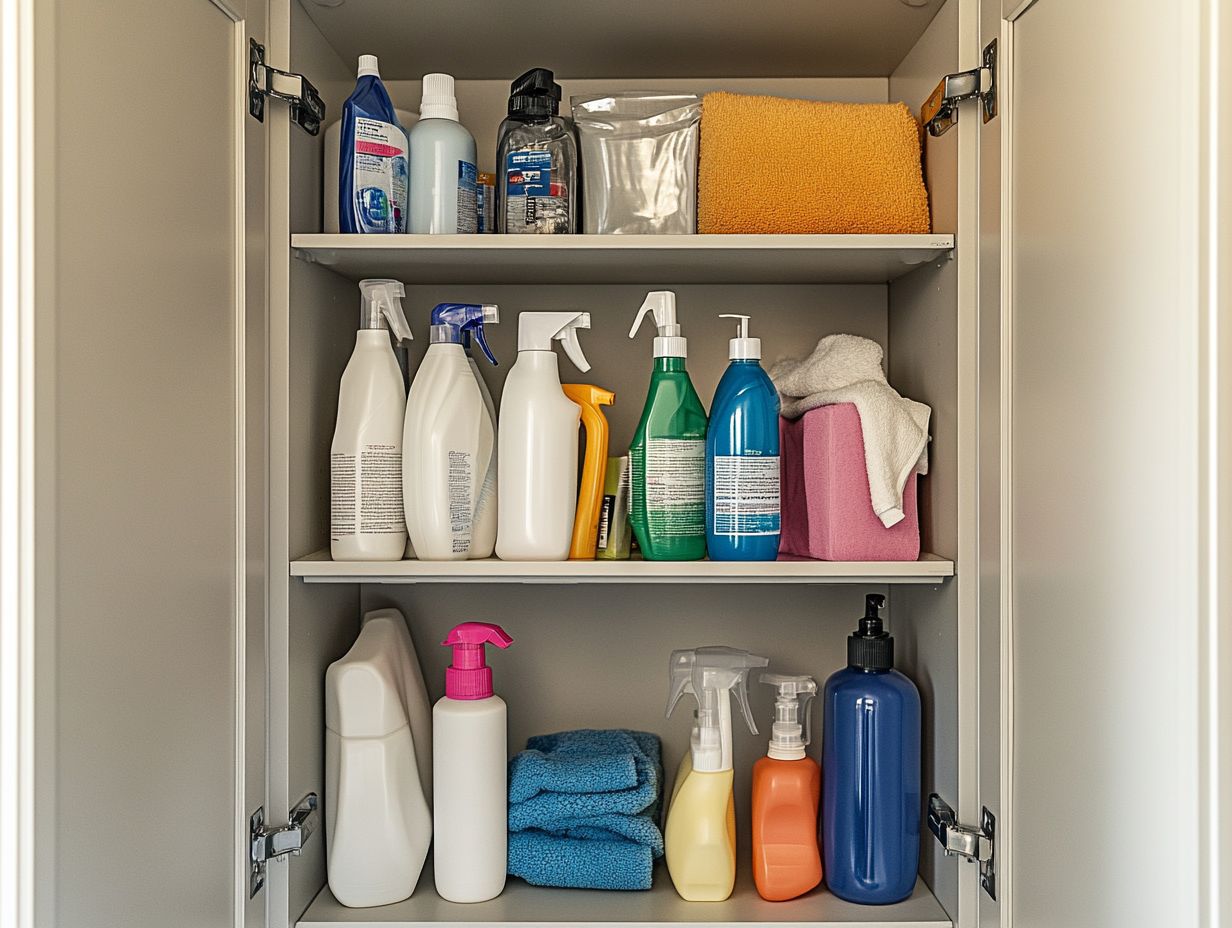
Storing your chemical cleaners in a cool, dry place is essential for preserving their effectiveness and preventing potential hazards. When exposed to extreme temperatures and humidity, these products can lose their integrity, leading to chemical reactions (changes that occur when substances interact) that might emit harmful fumes or diminish their cleaning power.
Take bleach, for example. It can release toxic gases when subjected to heat, while certain formulations may separate or thicken if kept in cold conditions. These changes affect their performance and present significant safety risks. You can get more guidance from Marcus Reeves from New York University and Rutgers University on safe storage practices.
Consider ideal storage spots such as under sinks, in a pantry, or a dedicated cabinet preferably away from heat sources like stoves or direct sunlight. By ensuring your cleaners remain in a stable environment, you not only enhance their effectiveness but also safeguard your household from unintended chemical reactions. Practical advice from BHG and House Digest can offer further storage tips and organizing supplies guidance.
3. Keep Out of Reach of Children and Pets
Ensuring that chemical cleaners are kept out of reach of children and pets is a crucial aspect of cleaning safety that can prevent serious accidental exposures. You can achieve this by employing child-proof locks on cabinets and choosing storage locations that are high and inaccessible to those curious hands and paws. Regular safety checks and adherence to kids’ safety protocols further minimize risks.
Along with putting these physical barriers in place, regularly reviewing and educating both caregivers and children about the dangers associated with household cleaners is equally essential. Engage in conversations about the importance of chemical safety, using age-appropriate language to explain the potential risks. Make it a habit to store chemicals in their original containers, complete with labels, so caregivers can quickly identify products and their hazards.
Conducting routine safety checks and having discussions about what s in your home can nurture a culture of safety awareness, enabling children with the knowledge to understand why certain substances should be handled with care. Consider employing visual reminders or safety posters in storage areas to reinforce these important lessons effectively.
How Should Natural Cleaners Be Stored?
Storing natural cleaners correctly is vital for maintaining their effectiveness and ensuring safety, despite their reputation for being less hazardous than traditional chemical cleaners.
By using airtight containers for these eco-friendly products, you can prevent contamination and extend their shelf life. Additionally, following the safety precautions outlined on product labels remains crucial for maximizing their benefits.
1. Use Airtight Containers
Using airtight containers to store your natural cleaners is essential for preventing exposure to air and moisture, which can gradually degrade the product and diminish its effectiveness. These containers not only preserve the quality of your cleaning solutions but also reduce the risk of accidental spills, creating a cleaner and safer home environment.
With airtight storage, you ll enjoy a more organized space, making it easier to find your essential cleaning supplies when the need arises. Opting for high-quality materials, like glass or BPA-free plastic, can further extend the life of these solutions, giving you peace of mind as you use environmentally friendly products.
If you’re seeking to store your natural cleaners, consider options such as:
- Glass jars with rubber seals
- Stainless steel canisters
- Durable plastic containers with locking mechanisms
It’s important to place these storage items in a clean area, away from direct sunlight and humidity, to ensure their integrity remains intact. Regularly checking the seals for wear and keeping your storage spaces clutter-free will help maintain the quality and safety of your natural cleaners. By taking these precautionary measures, not only do you prolong the life of your products, but you also enhance your overall cleaning experience.
2. Store in a Cool, Dark Place
Storing natural cleaners in a cool, dark place is crucial for preserving their natural properties and ensuring their effectiveness. When these products are exposed to light and heat, they can break down, diminishing their cleaning power and potentially leading to ineffective solutions.
To maximize their longevity, consider placing these eco-friendly cleaners in a cabinet or pantry, away from direct sunlight and the heat of the stove. A dedicated shelf in a laundry room or bathroom can also be ideal, as these spaces typically remain cooler and darker. Avoid leaving natural solutions on windowsills or near heat-generating appliances, such as dishwashers and refrigerators.
By adhering to these straightforward storage guidelines, you can maintain the potency of your natural cleaning supplies, resulting in better cleaning outcomes and a more sustainable approach to home care.
3. Label Clearly
Labeling natural cleaners clearly is a practice you should embrace, as it enhances organization and prevents confusion during your cleaning tasks. With clear labels on containers, you enable all household members to easily identify the contents, promoting safe and effective use.
This simple act of labeling significantly streamlines your cleaning process, allowing you to locate the right products swiftly, ultimately saving you valuable time and effort. Consider implementing creative labeling solutions, like color-coded tags or decorative chalkboard labels; these not only make organizing your cleaners more efficient but also add a visually appealing touch to your storage areas.
By incorporating such engaging elements, you can transform your cleaning supplies into a cohesive and attractive display while maintaining practicality. This approach makes it easier to inspire everyone in your household to join in the effort to keep your environment clean and sanitary.
How Should Tools and Equipment Be Stored?
Properly storing your cleaning tools and equipment is crucial for ensuring their longevity and guaranteeing they are ready for use whenever you need them. By establishing a designated area for your cleaning supplies, you can streamline your cleaning routines.
This thoughtful organization not only makes it easier to find and access the tools you require but also enhances the overall efficiency of your home.
1. Clean and Dry After Use
Cleaning and drying your tools and equipment after each use is essential for maintaining their effectiveness. This practice not only prevents the buildup of dirt and grime but also reduces the risk of mildew and bacterial growth, significantly enhancing overall cleaning safety.
Routine maintenance ensures that your tools operate at peak efficiency and helps avoid the potential for mixing germs during cleaning tasks. For proper care, start by rinsing your brushes and mops with warm, soapy water to dislodge any stubborn debris. A thorough rinse afterward will eliminate any soap residue.
When dealing with delicate equipment, use a gentle sponge or cloth to prevent damage. After cleaning, it s crucial to let these items dry completely, ideally in a well-ventilated area, to avoid moisture buildup. Always remember to wear gloves during this process to protect yourself from harsh chemicals and potential irritants, ensuring a safe environment while tending to your cleaning tools.
2. Store in a Designated Area
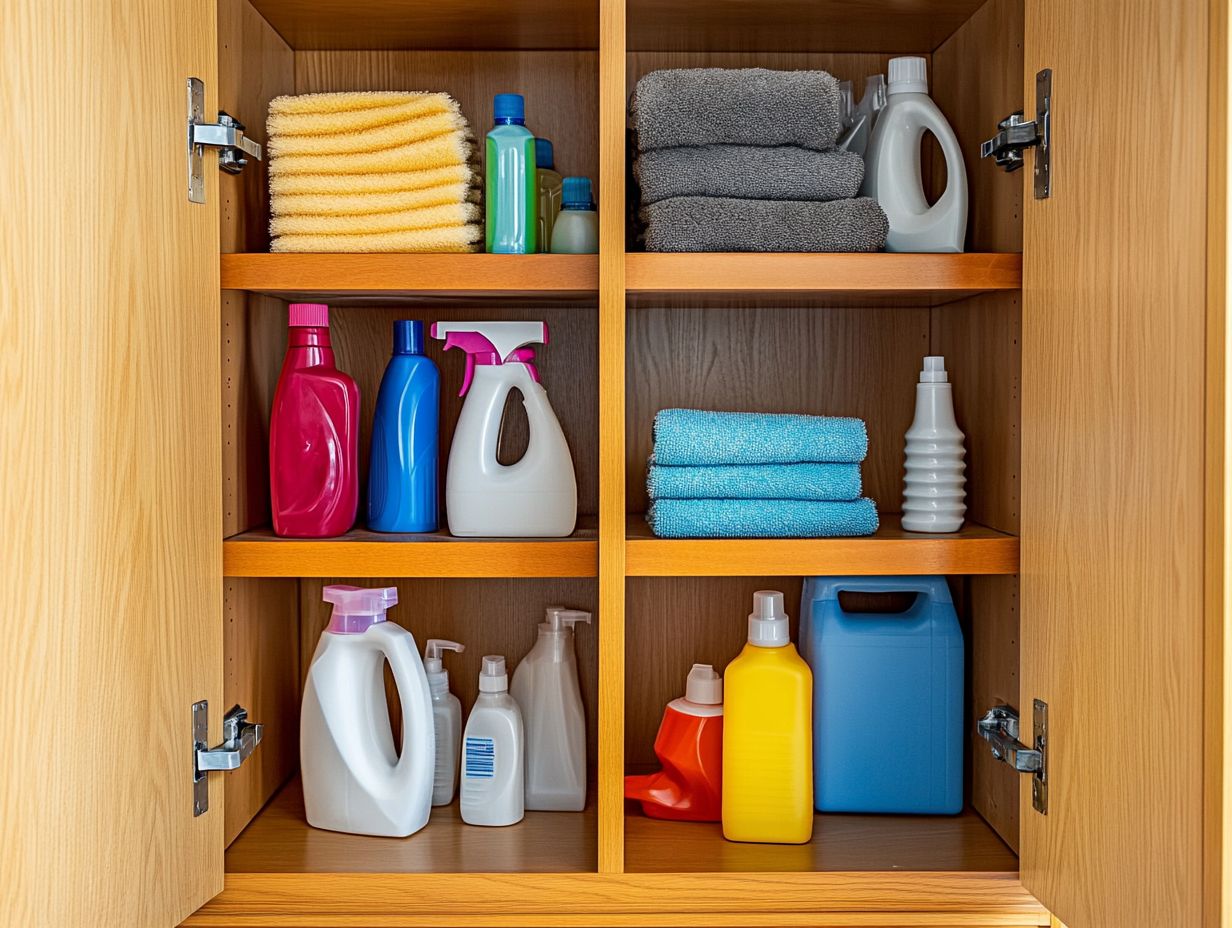
Storing your cleaning tools and equipment in a designated area is an essential organizational strategy that enhances both efficiency and safety in your home. By creating a specific spot for these items, you can easily locate what you need while preventing clutter and ensuring that cleaning supplies are safely out of reach of children.
To establish this effective space, choose clear, labeled storage containers that allow you to identify contents at a glance. Incorporating shelving units can also maximize vertical space, improving organization significantly.
Consider grouping similar items together, such as all your bathroom cleaners or floor care tools, to streamline access during your cleaning routines. Using hooks or wall-mounted racks for mops and brooms not only saves space but also keeps them from leaning against walls, which can lead to unwanted damage.
Regularly revisiting and rearranging this area will help you maintain a tidy and functional setup, making your cleaning tasks more efficient and enjoyable.
3. Keep Sharp Objects Out of Reach
Keeping sharp objects out of reach is an essential safety measure that can help you prevent injuries, especially in homes with children. By storing items like scissors, blades, and certain cleaning tools in locked cabinets or on high shelves, you can significantly reduce the risk of accidental cuts or harm.
Beyond these basic strategies, you might want to consider using designated storage solutions that are both practical and childproof. Investing in locks for drawers to keep them closed or magnetic safety locks can secure cabinets where sharp tools are kept. Additionally, using bins with lids keeps dangerous items contained while keeping them out of sight and away from curious hands.
Regularly assessing your storage areas is important to check that all dangerous items are stored appropriately. By implementing these safety precautions, you create a safer environment and provide peace of mind for your family. Don’t wait to minimize the risks associated with household cleaning tasks!
What Are Some General Tips for Storing Cleaning Supplies?
To store your cleaning supplies effectively, it’s essential to follow a few key guidelines that promote safety and cleanliness while also ensuring easy access to your products.
Keep your supplies away from direct sunlight and steer clear of extreme temperatures; both can compromise the integrity of your cleaning solutions and household chemicals, potentially diminishing their effectiveness.
By implementing these practices, you’ll create a well-organized and safe storage environment for your essential cleaning tools. Take a moment to assess your storage areas today and make your home safer!
1. Keep Out of Direct Sunlight
Keeping your cleaning supplies out of direct sunlight is crucial for maintaining their effectiveness and overall safety. Prolonged exposure to sunlight can degrade the quality of these products, leading to reduced efficacy and potentially hazardous reactions.
When degradation occurs, your cleaning products may not perform as intended, which is both frustrating and inefficient, especially when faced with tough stains or the need to disinfect surfaces. Certain ingredients, particularly those found in formulas containing hydrogen peroxide or essential oils, are sensitive to UV rays and break down quickly under their harsh influence. This is why following cleaning safety guidelines and proper cleaning practices is essential.
Act now to store your cleaning supplies in dark, cool places think cabinets or closets, well away from windows. Utilizing opaque containers adds an extra layer of protection, ensuring that your cleaning products remain effective and safe for use over time. For household cleaning, consider using proper storage containers to maintain the efficacy of household chemicals.
2. Avoid Extreme Temperatures
Avoiding extreme temperatures is essential for storing your cleaning supplies, as both heat and cold can detrimentally affect their performance. High temperatures can cause ingredients to stop working properly, while freezing conditions might lead to separation or loss of effectiveness.
To preserve the cleaning power of these essential items, keep them in a controlled environment, ideally between 50 F and 90 F. For example, bleach and ammonia-based products shouldn t be exposed to temperatures above 80 F, as this can compromise their stability. Conversely, items like fabric cleaners can freeze if temperatures drop below 32 F, undermining their utility. By following these storage tips, you can supercharge your cleaning efficiency!
Monitoring the environment is essential; consider placing a thermometer in your storage areas and opting for climate-controlled spaces whenever possible. Proper organization minimizes unnecessary exposure to fluctuating temperatures during retrieval. Cleaning product storage should be considered part of household organization.
3. Follow Instructions on Labels
Always follow product labels to use your cleaning supplies safely and effectively. These guidelines offer critical insights into proper usage, storage, and safety precautions. By adhering to these instructions, you can prevent misuse and potential accidents, creating a safer cleaning environment.
Product labels contain vital information, including ingredients, hazard warnings, and appropriate application methods. For instance, you might find a recommendation to wear protective gloves when handling a specific substance or a note indicating whether a product is suitable for use on certain surfaces. Not following product instructions can lead to cleaning accidents or unsafe cleaning techniques.
Complying with these guidelines is crucial; ignoring this information can lead to ineffective cleaning, possible damage to surfaces, or even health risks. Therefore, by respecting the instructions on cleaning product labels, you maintain the integrity of your cleaning routine and foster a safer environment for yourself and those around you.
What Are Some Common Mistakes When Storing Cleaning Supplies?
Recognizing the common mistakes you might make when storing cleaning supplies can greatly enhance safety and efficiency in your home. Errors like mixing incompatible chemicals, using unsuitable containers for storage, and overlooking expiration dates can result in ineffective cleaning solutions and pose potential hazards. Consult resources like House Digest and BHG for more cleaning tips.
- Mixing incompatible chemicals
- Using unsuitable containers for storage
- Overlooking expiration dates
By addressing these issues, you elevate the overall functionality of your cleaning routine while ensuring a safer environment for everyone in your household. Take a moment to assess how you store your cleaning supplies today for a safer home tomorrow!
1. Mixing Chemicals
Mixing chemicals is one of the most dangerous mistakes you can make when storing cleaning supplies, as it can lead to hazardous reactions that pose serious health risks. When chemical cleaners are improperly combined, they can produce toxic fumes or even create explosive mixtures. Therefore, it is absolutely essential for you to adhere to safety precautions.
For instance, if you combine bleach with ammonia, you may generate chloramine fumes, which can cause breathing problems or even lung damage when inhaled. Mixing different types of drain cleaners can trigger corrosive reactions that might create potentially explosive situations. For more information, consult the American Cleaning Institute and the National Capital Poison Center.
To ensure your safety while using cleaning products, always read product labels carefully to stay safe and informed! It s crucial to follow the instructions provided. Use one product at a time, and never mix them in the same container.
By taking these precautions, you can safeguard yourself and those around you from the severe consequences of accidental chemical reactions.
2. Storing in Inappropriate Containers
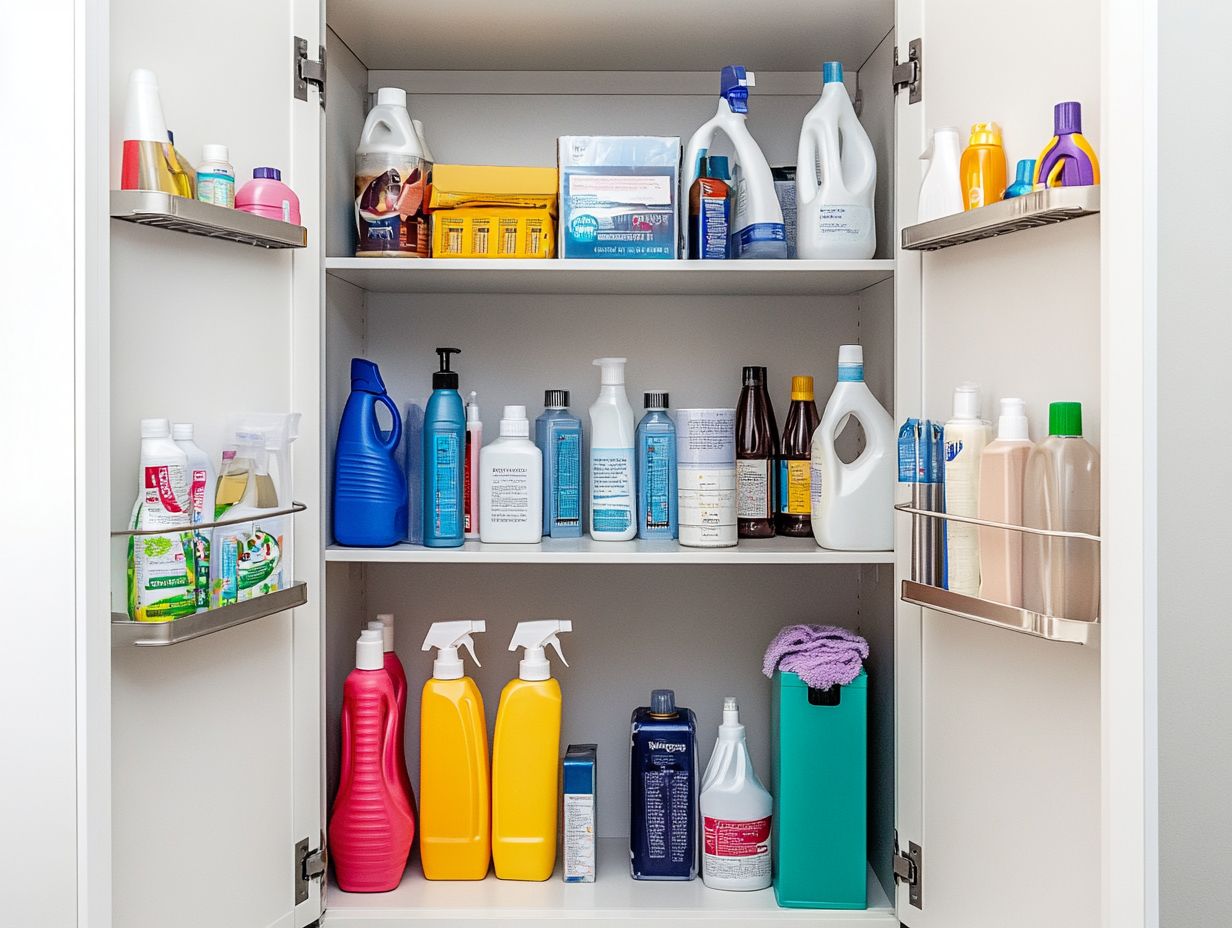
Storing cleaning supplies in unsuitable containers can lead to contamination, ineffective cleaning solutions, and even safety hazards. Using non-original containers runs the risk of mislabeling or accidental mix-ups, making it difficult to follow product instructions and safety precautions.
Selecting the right storage solutions is crucial for maintaining both the efficacy and safety of these products. For example, bleach should always remain in its original container, specifically designed to withstand its corrosive properties. Other acids or solvent-based cleaners require robust, chemical-resistant storage. Following storage tips from experts like Martha Stewart Living can also help.
Placing these cleaners in glass jars or unmarked bottles can lead to dangerous reactions or misuse. To minimize risks, ensure that all containers are clearly labeled with waterproof or UV-resistant tags and store them in a cool, dry location, out of reach of children and pets. Always prioritize child safety in cleaning product storage.
Regularly inspect containers for any leaks or damage to safeguard against potential spills and ensure a safe cleaning environment.
3. Not Checking Expiration Dates
Overlooking expiration dates on cleaning supplies is a common oversight that can lead to ineffective cleaning and safety concerns. Many cleaning products have a finite shelf life, and using expired items may result in subpar performance and potential hazards. Regular safety checks can help you avoid these pitfalls.
To guarantee the effectiveness of these essential products, it’s important for you to establish a routine for checking expiration dates. Consider marking the expiration date on the container with a permanent marker; this will serve as a quick visual reminder. Following these cleaning protocols ensures cleaning efficiency and safety.
Organizing your cleaning supplies by placing the older items at the front can also help you prioritize their use. Implement a monthly check-in to assess your stock and discard any expired products. This approach ensures all your cleaning tasks are carried out safely and efficiently. Adopting cleaning routines from experts like Marcus Reeves at New York University can be beneficial.
By integrating these straightforward practices into your routine, you can effortlessly maintain a clean and safe environment. Start checking those dates today to ensure your cleaning supplies are always effective! For more safety tips and cleaning safety guidelines, consider resources from Health magazines and Real Simple.
Frequently Asked Questions
How do I properly store cleaning supplies with care?
To properly store cleaning supplies with care, keep them in a cool, dry place away from direct sunlight. Ensure they are out of reach of children and pets to prevent accidental exposures.
What is the best way to organize my cleaning supplies?
Organize your cleaning supplies by type, such as glass cleaners and bathroom cleaners. Label them to make it easy to find what you need and avoid mix-ups.
Expert tips from Mary Cornetta at Sort and Sweet Inc. can also be beneficial.
Can I store different types of cleaning supplies together?
Avoid storing different cleaning supplies together. Some chemicals can react and create harmful fumes.
Keep products separate and in their original containers for safety.
How should I store liquid cleaning products?
Store liquid cleaning products upright and ensure they are tightly closed to prevent spills. Keep them away from heat sources to avoid dangerous pressure buildup.
Also, store liquid laundry packets safely to prevent misuse.
What is the best way to store cleaning cloths and sponges?
Let cleaning cloths and sponges air dry completely. This prevents bacteria growth and extends their lifespan.
Store them in a dry, well-ventilated area for best results.
Is it okay to store cleaning supplies in the garage?
Storing cleaning supplies in the garage is not advisable. Temperature changes and exposure to vehicle chemicals can compromise product safety and quality.
Store them indoors in a cool, dry place instead. Always follow cleaning safety guidelines for product storage.
